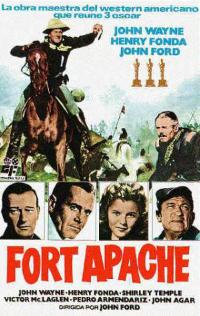
Stagecoach is a 1939 American Western film directed by John Ford and starring Claire Trevor and John Wayne in his breakthrough role. The screenplay by Dudley Nichols is an adaptation of "The Stage to Lordsburg", a 1937 short story by Ernest Haycox. The film follows a group primarily composed of strangers riding on a stagecoach through dangerous Apache territory.

John Martin Feeney, known professionally as John Ford, was an American film director and producer. He is regarded as one of the most important and influential filmmakers during the Golden Age of Hollywood, and was one of the first American directors to be recognized as an auteur. In a career of more than 50 years, he directed over 140 films between 1917 and 1965, and received six Academy Awards including a record four wins for Best Director for The Informer (1935), The Grapes of Wrath (1940), How Green Was My Valley (1941), and The Quiet Man (1952).

Wardell Edwin Bond was an American film character actor who appeared in more than 200 films and starred in the NBC television series Wagon Train from 1957 to 1960. Among his best-remembered roles are Bert the cop in Frank Capra's It's a Wonderful Life (1946) and Captain Clayton in John Ford's The Searchers (1956). As a character actor, Bond frequently played cowboys, cops and soldiers.

Rio Grande is a 1950 American romantic Western film directed by John Ford and starring John Wayne and Maureen O'Hara. It is the third installment of Ford's "Cavalry Trilogy", following two RKO Pictures releases: Fort Apache (1948) and She Wore a Yellow Ribbon (1949). Wayne plays the lead in all three films, as Captain Kirby York in Fort Apache, then as Captain Nathan Brittles in She Wore a Yellow Ribbon, and finally as a promoted Lieutenant Colonel Kirby Yorke in Rio Grande. Rio Grande's supporting cast features Ben Johnson, Claude Jarman Jr., Harry Carey Jr., Chill Wills, J. Carrol Naish, Victor McLaglen, Grant Withers, the Western singing group the Sons of the Pioneers and Stan Jones.

The Apache Wars were a series of armed conflicts between the United States Army and various Apache tribal confederations fought in the southwest between 1849 and 1886, though minor hostilities continued until as late as 1924. After the Mexican–American War in 1846, the United States annexed conflicted territory from Mexico which was the home of both settlers and Apache tribes. Conflicts continued as white colonizers came into traditional Apache lands to raise livestock and crops and to mine minerals.

Benjamin Franklin "Frank" McGrath was an American television and film actor and stunt performer who played the comical, optimistic cook with the white beard, Charlie B. Wooster, on the western series Wagon Train for five seasons on NBC and then three seasons on ABC. McGrath appeared in all 272 episodes in the eight seasons of the series, which had ended its run only two years before his death. McGrath's Wooster character hence provided the meals and companionship for both fictional trail masters, Ward Bond as Seth Adams and John McIntire as Christopher "Chris" Hale.

Francis Ford was an American film actor, writer and director. He was the mentor and elder brother of film director John Ford. As an actor, director and producer, he was one of the first filmmakers in Hollywood.

John Arthur Doucette was an American character actor who performed in more than 280 film and television productions between 1941 and 1987. A man of stocky build who possessed a deep, rich voice, he proved equally adept at portraying characters in Shakespearean plays, Westerns, and modern crime dramas. He is perhaps best remembered, however, for his villainous roles as a movie and television "tough guy".

She Wore a Yellow Ribbon is a 1949 American Technicolor Western film directed by John Ford and starring John Wayne. It is the second film in Ford's "Cavalry Trilogy", along with Fort Apache (1948) and Rio Grande (1950). With a budget of $1.6 million, the film was one of the most expensive Westerns made up to that time. It was a major hit for RKO. The film is named after "She Wore a Yellow Ribbon", a song popular with the US military.

Hondo is a 1953 Warnercolor 3D Western film directed by John Farrow and starring John Wayne and Geraldine Page. The screenplay is based on the 1952 Collier's short story "The Gift of Cochise" by Louis L'Amour. The book Hondo was a novelization of the film also written by L'Amour, and published by Gold Medal Books in 1953. The supporting cast features Ward Bond, James Arness and Leo Gordon.
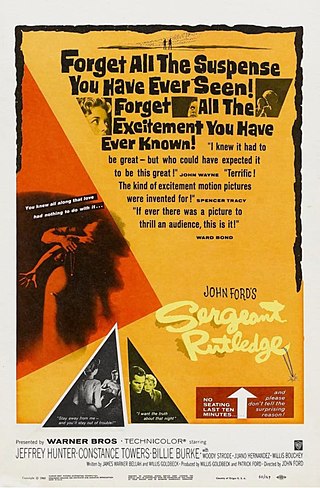
Sergeant Rutledge is a 1960 American Technicolor Western film directed by John Ford and starring Jeffrey Hunter, Constance Towers, Woody Strode and Billie Burke. The title was also used for the novelization published in the same year. Six decades later, the film continues to attract attention because it was one of the first mainstream films in the U.S. to treat racism frankly and to give a starring role to an African-American actor. In 2017, film critic Richard Brody observed that "The greatest American political filmmaker, John Ford, relentlessly dramatized, in his Westerns, the mental and historical distortions arising from the country’s violent origins—including its legacy of racism, which he confronted throughout his career, nowhere more radically than in Sergeant Rutledge."
James Warner Bellah was an American Western author from the 1930s to the 1950s. His pulp-fiction writings on cavalry and Indians were published in paperbacks or serialized in the Saturday Evening Post.
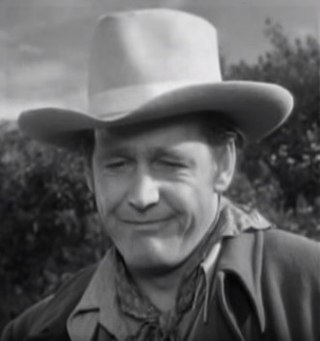
Myron Daniel Healey was an American actor. He began his career in Hollywood, California during the early 1940s and eventually made hundreds of appearances in movies and on television during a career spanning more than half a century.

Only the Valiant, also known as Fort Invincible, is a 1951 American Western film produced by William Cagney, directed by Gordon Douglas and starring Gregory Peck, Barbara Payton, and Ward Bond. The screenplay was written by Edmund H. North and Harry Brown, based on the 1943 novel of the same name by Charles Marquis Warren.

Indian Uprising is a 1952 American Western film directed by Ray Nazarro and starring George Montgomery, Audrey Long and Carl Benton Reid.
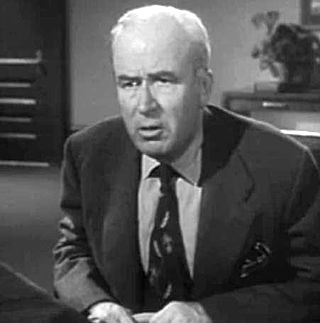
Harry Shannon was an American character actor. He often appeared in Western films.
First Sergeant Rudolph Stauffer was a Swiss-born American soldier in the U.S. Army who served with the 5th U.S. Cavalry in the Apache Wars. He was one of twelve soldiers, along with ten Apache Scouts, awarded the Medal of Honor during Lieutenant Colonel George Crook's "winter campaign" of 1872–73, being cited for gallantry in battle against renegade Apaches near Camp Hualpai. Charles King, while serving with the 5th U.S. Cavalry in his youth, wrote of him in his memoirs as "grim old Stauffer, the first sergeant".

The Last Outpost is a 1951 American Technicolor Western film directed by Lewis R. Foster, set in the American Civil War with brothers on opposite sides. This film is character actor Burt Mustin's film debut at the age of 67.
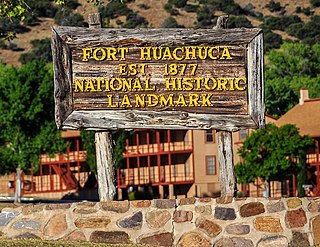
This is a list with images of some of the historic structures and places in the Fort Huachuca National Historic District in Arizona. The district, also known as Old Fort Huachuca, is located within Fort Huachuca an active United States Army installation under the command of the United States Army Installation Management Command. The fort sits at the base of the Huachuca Mountains four miles west of the town of Sierra Vista, on AZ 90 in Cochise County, Arizona.
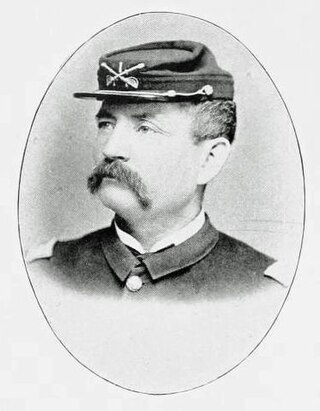
Henry Carroll was an American brigadier general of the American Civil War and the Spanish–American War. He was known for commanding the 1st Brigade of the Cavalry Division during the Battle of San Juan Hill but was wounded during the battle and had to be succeeded by Brigadier General Samuel S. Sumner.
